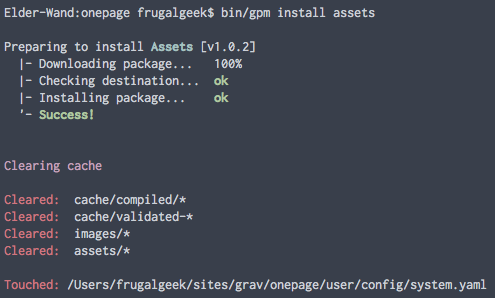assets is a Grav plugin that provides a convenient way to add CSS and JS assets directly from your pages.
Installing the Assets plugin can be done in one of two ways. Our GPM (Grav Package Manager) installation method enables you to quickly and easily install the plugin with a simple terminal command, while the manual method enables you to do so via a zip file.
The simplest way to install this plugin is via the Grav Package Manager (GPM) through your system's Terminal (also called the command line). From the root of your Grav install type:
bin/gpm install assets
This will install the Assets plugin into your /user/plugins directory within Grav. Its files can be found under /your/site/grav/user/plugins/assets.
To install this plugin, just download the zip version of this repository and unzip it under /your/site/grav/user/plugins. Then, rename the folder to assets. You can find these files either on GitHub or via GetGrav.org.
You should now have all the plugin files under
/your/site/grav/user/plugins/assets
NOTE: This plugin is a modular component for Grav which requires Grav, the Error and Problems plugins, and a theme to be installed in order to operate.
enabled: true
If you need to change any value, then the best process is to copy the assets.yaml file into your users/config/plugins/ folder (create it if it doesn't exist), and then modify there. This will override the default settings.
Once the plugin is installed you can use the following syntax to add various asset types, where default order is 10 for js and css types:
{assets:css order:5}
custom-style.css
/blog/some-blog/post/style.css
//cdnjs.cloudflare.com/ajax/libs/1140/2.0/1140.css
http://somesite.com/js/cookies.min.css
{/assets}
{assets:js order:10}
custom-script.js
/blog/some-blog/post/script.js
//cdnjs.cloudflare.com/ajax/libs/1140/2.0/1140.min.js
http://somesite.com/js/cookies.min.js
{/assets}
{assets:inline_css}
h1 {color: red !important;}
{/assets}
{assets:inline_js}
function initialize() {
var mapCanvas = document.getElementById('map_canvas');
var mapOptions = {
center: new google.maps.LatLng(44.5403, -78.5463),
zoom: 8,
mapTypeId: google.maps.MapTypeId.ROADMAP
}
var map = new google.maps.Map(mapCanvas, mapOptions);
}
{/assets}
Note: If you want to see this plugin in action, have a look at Grav Learn Site
As development for the Assets plugin continues, new versions may become available that add additional features and functionality, improve compatibility with newer Grav releases, and generally provide a better user experience. Updating Assets is easy, and can be done through Grav's GPM system, as well as manually.
The simplest way to update this plugin is via the Grav Package Manager (GPM). You can do this with this by navigating to the root directory of your Grav install using your system's Terminal (also called command line) and typing the following:
bin/gpm update assets
This command will check your Grav install to see if your Assets plugin is due for an update. If a newer release is found, you will be asked whether or not you wish to update. To continue, type y and hit enter. The plugin will automatically update and clear Grav's cache.
Manually updating Assets is pretty simple. Here is what you will need to do to get this done:
- Delete the
your/site/user/plugins/assetsdirectory. - Download the new version of the Assets plugin from either GitHub or GetGrav.org.
- Unzip the zip file in
your/site/user/pluginsand rename the resulting folder toassets. - Clear the Grav cache. The simplest way to do this is by going to the root Grav directory in terminal and typing
bin/grav clear-cache.
Note: Any changes you have made to any of the files listed under this directory will also be removed and replaced by the new set. Any files located elsewhere (for example a YAML settings file placed in
user/config/plugins) will remain intact.
